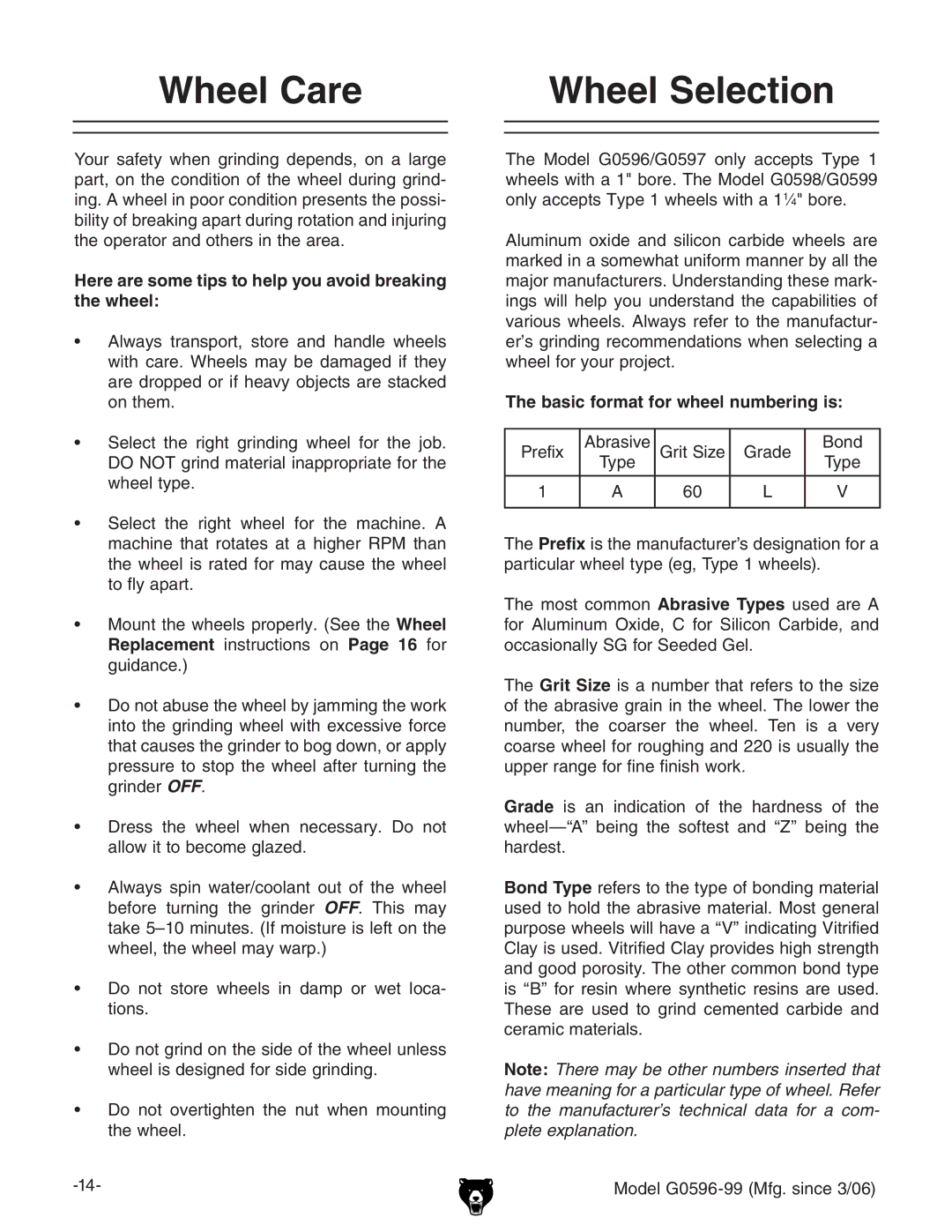Wheel Care |
| Wheel Selection |
|
|
|
|
|
|
Your safety when grinding depends, on a large part, on the condition of the wheel during grind- ing. A wheel in poor condition presents the possi- bility of breaking apart during rotation and injuring the operator and others in the area.
Here are some tips to help you avoid breaking the wheel:
•Always transport, store and handle wheels with care. Wheels may be damaged if they are dropped or if heavy objects are stacked on them.
•Select the right grinding wheel for the job. DO NOT grind material inappropriate for the wheel type.
•Select the right wheel for the machine. A machine that rotates at a higher RPM than the wheel is rated for may cause the wheel to fly apart.
•Mount the wheels properly. (See the Wheel Replacement instructions on Page 16 for guidance.)
•Do not abuse the wheel by jamming the work into the grinding wheel with excessive force that causes the grinder to bog down, or apply pressure to stop the wheel after turning the grinder OFF.
•Dress the wheel when necessary. Do not allow it to become glazed.
•Always spin water/coolant out of the wheel before turning the grinder OFF. This may take
•Do not store wheels in damp or wet loca- tions.
•Do not grind on the side of the wheel unless wheel is designed for side grinding.
•Do not overtighten the nut when mounting the wheel.
The Model G0596/G0597 only accepts Type 1 wheels with a 1" bore. The Model G0598/G0599 only accepts Type 1 wheels with a 11⁄4" bore.
Aluminum oxide and silicon carbide wheels are marked in a somewhat uniform manner by all the major manufacturers. Understanding these mark- ings will help you understand the capabilities of various wheels. Always refer to the manufactur- er’s grinding recommendations when selecting a wheel for your project.
The basic format for wheel numbering is:
Prefix | Abrasive | Grit Size | Grade | Bond |
| Type |
|
| Type |
1 | A | 60 | L | V |
|
|
|
|
|
The Prefix is the manufacturer’s designation for a particular wheel type (eg, Type 1 wheels).
The most common Abrasive Types used are A for Aluminum Oxide, C for Silicon Carbide, and occasionally SG for Seeded Gel.
The Grit Size is a number that refers to the size of the abrasive grain in the wheel. The lower the number, the coarser the wheel. Ten is a very coarse wheel for roughing and 220 is usually the upper range for fine finish work.
Grade is an indication of the hardness of the
Bond Type refers to the type of bonding material used to hold the abrasive material. Most general purpose wheels will have a “V” indicating Vitrified Clay is used. Vitrified Clay provides high strength and good porosity. The other common bond type is “B” for resin where synthetic resins are used. These are used to grind cemented carbide and ceramic materials.
Note: There may be other numbers inserted that have meaning for a particular type of wheel. Refer to the manufacturer’s technical data for a com- plete explanation.
Model
